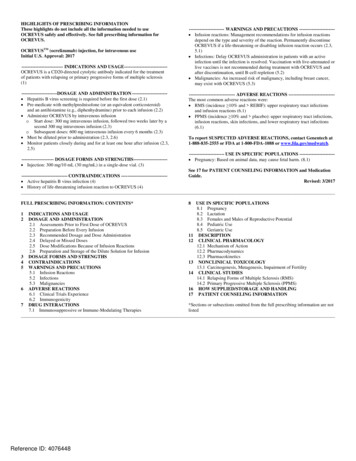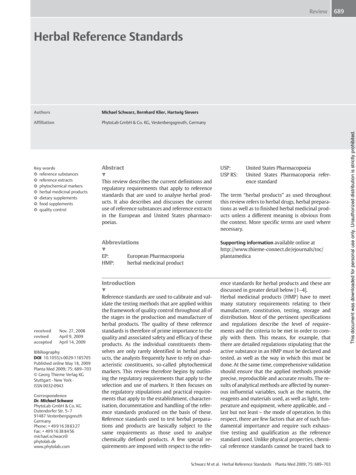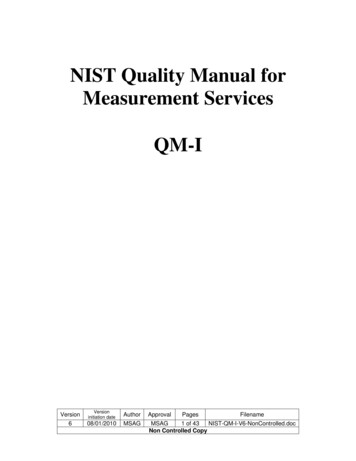
Transcription
HIGHLIGHTS OF PRESCRIBING INFORMATIONThese highlights do not include all the information needed to useOCREVUS safely and effectively. See full prescribing information forOCREVUS.OCREVUSTM (ocrelizumab) injection, for intravenous useInitial U.S. Approval: 2017--------------------------- INDICATIONS AND USAGE ---------------------------OCREVUS is a CD20-directed cytolytic antibody indicated for the treatmentof patients with relapsing or primary progressive forms of multiple sclerosis(1)----------------------- DOSAGE AND ADMINISTRATION ---------------------- Hepatitis B virus screening is required before the first dose (2.1) Pre-medicate with methylprednisolone (or an equivalent corticosteroid)and an antihistamine (e.g., diphenhydramine) prior to each infusion (2.2) Administer OCREVUS by intravenous infusiono Start dose: 300 mg intravenous infusion, followed two weeks later by asecond 300 mg intravenous infusion (2.3)o Subsequent doses: 600 mg intravenous infusion every 6 months (2.3) Must be diluted prior to administration (2.3, 2.6) Monitor patients closely during and for at least one hour after infusion (2.3,2.5)--------------------- DOSAGE FORMS AND STRENGTHS--------------------- Injection: 300 mg/10 mL (30 mg/mL) in a single-dose vial. (3)----------------------- WARNINGS AND PRECAUTIONS ---------------------- Infusion reactions: Management recommendations for infusion reactionsdepend on the type and severity of the reaction. Permanently discontinueOCREVUS if a life-threatening or disabling infusion reaction occurs (2.3,5.1) Infections: Delay OCREVUS administration in patients with an activeinfection until the infection is resolved. Vaccination with live-attenuated orlive vaccines is not recommended during treatment with OCREVUS andafter discontinuation, until B-cell repletion (5.2) Malignancies: An increased risk of malignancy, including breast cancer,may exist with OCREVUS (5.3)------------------------------ ADVERSE REACTIONS -----------------------------The most common adverse reactions were: RMS (incidence 10% and REBIF): upper respiratory tract infectionsand infusion reactions (6.1) PPMS (incidence 10% and placebo): upper respiratory tract infections,infusion reactions, skin infections, and lower respiratory tract infections(6.1)To report SUSPECTED ADVERSE REACTIONS, contact Genentech at1-888-835-2555 or FDA at 1-800-FDA-1088 or www.fda.gov/medwatch.----------------------- USE IN SPECIFIC POPULATIONS ---------------------- Pregnancy: Based on animal data, may cause fetal harm. (8.1)See 17 for PATIENT COUNSELING INFORMATION and MedicationGuide.------------------------------ CONTRAINDICATIONS -----------------------------Revised: 3/2017 Active hepatitis B virus infection (4) History of life-threatening infusion reaction to OCREVUS (4)FULL PRESCRIBING INFORMATION: CONTENTS*128USE IN SPECIFIC POPULATIONS8.1 Pregnancy8.2 Lactation8.3 Females and Males of Reproductive Potential8.4 Pediatric Use8.5 Geriatric UseDESCRIPTIONCLINICAL PHARMACOLOGY12.1 Mechanism of Action12.2 Pharmacodynamics12.3 PharmacokineticsNONCLINICAL TOXICOLOGY13.1 Carcinogenesis, Mutagenesis, Impairment of FertilityCLINICAL STUDIES14.1 Relapsing Forms of Multiple Sclerosis (RMS)14.2 Primary Progressive Multiple Sclerosis (PPMS)HOW SUPPLIED/STORAGE AND HANDLINGPATIENT COUNSELING INFORMATIONINDICATIONS AND USAGEDOSAGE AND ADMINISTRATION2.1 Assessments Prior to First Dose of OCREVUS2.2 Preparation Before Every Infusion2.3 Recommended Dosage and Dose Administration112.4 Delayed or Missed Doses122.5 Dose Modifications Because of Infusion Reactions2.6 Preparation and Storage of the Dilute Solution for Infusion3 DOSAGE FORMS AND STRENGTHS134 CONTRAINDICATIONS5 WARNINGS AND PRECAUTIONS5.1 Infusion Reactions145.2 Infections5.3 Malignancies166 ADVERSE REACTIONS6.1 Clinical Trials Experience176.2 Immunogenicity*Sections or subsections omitted from the full prescribing information are not7 DRUG INTERACTIONSlisted7.1 Immunosuppressive or Immune-Modulating TherapiesReference ID: 4076448
FULL PRESCRIBING INFORMATION1INDICATIONS AND USAGEOCREVUS is indicated for the treatment of adult patients with relapsing or primary progressive forms ofmultiple sclerosis.2DOSAGE AND ADMINISTRATION2.1 Assessments Prior to First Dose of OCREVUSHepatitis B Virus ScreeningPrior to initiating OCREVUS, perform Hepatitis B virus (HBV) screening. OCREVUS is contraindicated inpatients with active HBV confirmed by positive results for HBsAg and anti-HBV tests. For patients who arenegative for surface antigen [HBsAg] and positive for HB core antibody [HBcAb ] or are carriers of HBV[HBsAg ], consult liver disease experts before starting and during treatment [see Warnings and Precautions(5.2)].VaccinationsBecause vaccination with live-attenuated or live vaccines is not recommended during treatment and afterdiscontinuation until B-cell repletion, administer all necessary immunizations according to immunizationguidelines at least 6 weeks prior to initiation of OCREVUS [see Warnings and Precautions (5.2) and ClinicalPharmacology (12.2)].2.2 Preparation Before Every InfusionInfection AssessmentPrior to every infusion of OCREVUS, determine whether there is an active infection. In case of active infection,delay infusion of OCREVUS until the infection resolves [see Warnings and Precautions (5.2)].Recommended PremedicationPre-medicate with 100 mg of methylprednisolone (or an equivalent corticosteroid) administered intravenouslyapproximately 30 minutes prior to each OCREVUS infusion to reduce the frequency and severity of infusionreactions [see Warnings and Precautions (5.1)]. Pre-medicate with an antihistamine (e.g., diphenhydramine)approximately 30-60 minutes prior to each OCREVUS infusion to further reduce the frequency and severity ofinfusion reactions.The addition of an antipyretic (e.g., acetaminophen) may also be considered.2.3 Recommended Dosage and Dose AdministrationAdminister OCREVUS under the close supervision of an experienced healthcare professional with access toappropriate medical support to manage severe reactions such as serious infusion reactions. Initial dose: 300 mg intravenous infusion, followed two weeks later by a second 300 mg intravenousinfusion.Subsequent doses: single 600 mg intravenous infusion every 6 months.Observe the patient for at least one hour after the completion of the infusion [see Warnings andPrecautions (5.1)].Reference ID: 4076448
Table 1Recommended Dose, Infusion Rate, and Infusion Duration for RMS and PPMSAmount and Volume1Initial Dose(two infusions)SubsequentDoses(one infusion)Infusion 1300 mgin 250 mLInfusion 2(2 weeks later)300 mgin 250 mLOne infusionevery 6months2600 mgin 500 mLInfusion Rate and Duration3 Start at 30 mL per hourIncrease by 30 mL per hour every 30 minutesMaximum: 180 mL per hourDuration: 2.5 hours or longer Start at 40 mL per hourIncrease by 40 mL per hour every 30 minutesMaximum: 200 mL per hourDuration: 3.5 hours or longer1Solutions of OCREVUS for intravenous infusion are prepared by dilution of the drug product into an infusion bagcontaining 0.9% Sodium Chloride Injection, to a final drug concentration of approximately 1.2 mg/mL.2Administer the first Subsequent Dose 6 months after Infusion 1 of the Initial Dose.3Infusion time may take longer if the infusion is interrupted or slowed [see Dosage and Administration (2.5)].2.4 Delayed or Missed DosesIf a planned infusion of OCREVUS is missed, administer OCREVUS as soon as possible; do not wait until thenext scheduled dose. Reset the dose schedule to administer the next sequential dose 6 months after the misseddose is administered. Doses of OCREVUS must be separated by at least 5 months [see Dosage andAdministration (2.3)].2.5 Dose Modifications Because of Infusion ReactionsDose modifications in response to infusion reactions depends on the severity.Life-threatening Infusion ReactionsImmediately stop and permanently discontinue OCREVUS if there are signs of a life-threatening or disablinginfusion reaction [see Warnings and Precautions (5.1)]. Provide appropriate supportive treatment.Severe Infusion ReactionsImmediately interrupt the infusion and administer appropriate supportive treatment, as necessary [see Warningsand Precautions (5.1)]. Restart the infusion only after all symptoms have resolved. When restarting, begin athalf of the infusion rate at the time of onset of the infusion reaction [see Dosage and Administration (2.2)]. Ifthis rate is tolerated, increase the rate as described in Table 1. This change in rate will increase the totalduration of the infusion but not the total dose.Mild to Moderate Infusion ReactionsReduce the infusion rate to half the rate at the onset of the infusion reaction and maintain the reduced rate for atleast 30 minutes [see Warnings and Precautions (5.1)]. If this rate is tolerated, increase the rate as described inTable 1. This change in rate will increase the total duration of the infusion but not the total dose.2.6 Preparation and Storage of the Dilute Solution for InfusionPreparationOCREVUS must be prepared by a healthcare professional using aseptic technique.Visually inspect for particulate matter and discoloration prior to administration. Do not use the solution ifdiscolored or if the solution contains discrete foreign particulate matter. Do not shake.Withdraw intended dose and further dilute into an infusion bag containing 0.9% Sodium Chloride Injection, to afinal drug concentration of approximately 1.2 mg/mL.Reference ID: 4076448
Withdraw 10 mL (300 mg) of OCREVUS and inject into 250 mL Withdraw 20 mL (600 mg) of OCREVUS and inject into 500 mLDo not use other diluents to dilute OCREVUS since their use has not been tested. The product contains nopreservative and is intended for single use only.Storage of Infusion SolutionPrior to the start of the intravenous infusion, the content of the infusion bag should be at room temperature.Use the prepared infusion solution immediately. If not used immediately, store up to 24 hours in the refrigeratorat 2 C–8 C (36 F–46 F) and 8 hours at room temperature up to 25 C (77 F), which includes infusion time. Inthe event an intravenous infusion cannot be completed the same day, discard the remaining solution.No incompatibilities between OCREVUS and polyvinyl chloride (PVC) or polyolefin (PO) bags andintravenous (IV) administration sets have been observed.AdministrationAdminister the diluted infusion solution through a dedicated line using an infusion set with a 0.2 or 0.22 micronin-line filter.3DOSAGE FORMS AND STRENGTHSInjection: 300 mg/10 mL (30 mg/mL) clear or slightly opalescent, and colorless to pale brown solution in asingle-dose vial.4CONTRAINDICATIONSOCREVUS is contraindicated in patients with:5 Active HBV infection [see Dosage and Administration (2.6) and Warnings and Precautions (5.2)] A history of life-threatening infusion reaction to OCREVUS [see Warnings and Precautions (5.1)]WARNINGS AND PRECAUTIONS5.1 Infusion ReactionsOCREVUS can cause infusion reactions, which can include pruritus, rash, urticaria, erythema, bronchospasm,throat irritation, oropharyngeal pain, dyspnea, pharyngeal or laryngeal edema, flushing, hypotension, pyrexia,fatigue, headache, dizziness, nausea, and tachycardia. In multiple sclerosis (MS) clinical trials, the incidence ofinfusion reactions in OCREVUS-treated patients [who received methylprednisolone (or an equivalent steroid)and possibly other pre-medication to reduce the risk of infusion reactions prior to each infusion] was 34 to 40%,with the highest incidence with the first infusion. There were no fatal infusion reactions, but 0.3% ofOCREVUS-treated MS patients experienced infusion reactions that were serious, some requiring hospitalization.Observe patients treated with OCREVUS for infusion reactions during the infusion and for at least one hourafter completion of the infusion. Inform patients that infusion reactions can occur up to 24 hours after theinfusion.Reducing the Risk of Infusion Reactions and Managing Infusion ReactionsAdminister pre-medication (e.g., methylprednisolone or an equivalent corticosteroid, and an antihistamine) toreduce the frequency and severity of infusion reactions. The addition of an antipyretic (e.g., acetaminophen)may also be considered [see Dosage and Administration (2.3)].Reference ID: 4076448
Management recommendations for infusion reactions depend on the type and severity of the reaction [seeDosage and Administration (2.5)]. For life-threatening infusion reactions, immediately and permanently stopOCREVUS and administer appropriate supportive treatment. For less severe infusion reactions, managementmay involve temporarily stopping the infusion, reducing the infusion rate, and/or administering symptomatictreatment.5.2 InfectionsA higher proportion of OCREVUS-treated patients experienced infections compared to patients taking REBIFor placebo. In RMS trials, 58% of OCREVUS-treated patients experienced one or more infections compared to52% of REBIF-treated patients. In the PPMS trial, 70% of OCREVUS-treated patients experienced one or moreinfections compared to 68% of patients on placebo. OCREVUS increased the risk for upper respiratory tractinfections, lower respiratory tract infections, skin infections, and herpes-related infections [see AdverseReactions (6.1)]. OCREVUS was not associated with an increased risk of serious infections in MS patients.Delay OCREVUS administration in patients with an active infection until the infection is resolved.Respiratory Tract InfectionsA higher proportion of OCREVUS-treated patients experienced respiratory tract infections compared to patientstaking REBIF or placebo. In RMS trials, 40% of OCREVUS-treated patients experienced upper respiratory tractinfections compared to 33% of REBIF-treated patients, and 8% of OCREVUS-treated patients experiencedlower respiratory tract infections compared to 5% of REBIF-treated patients. In the PPMS trial, 49% ofOCREVUS-treated patients experi
fatigue, headache, dizziness, nausea, and tachycardia. In multiple sclerosis (MS) clinical trials, the incidence of infusion reactions in OCREVUS-treated patients [who










